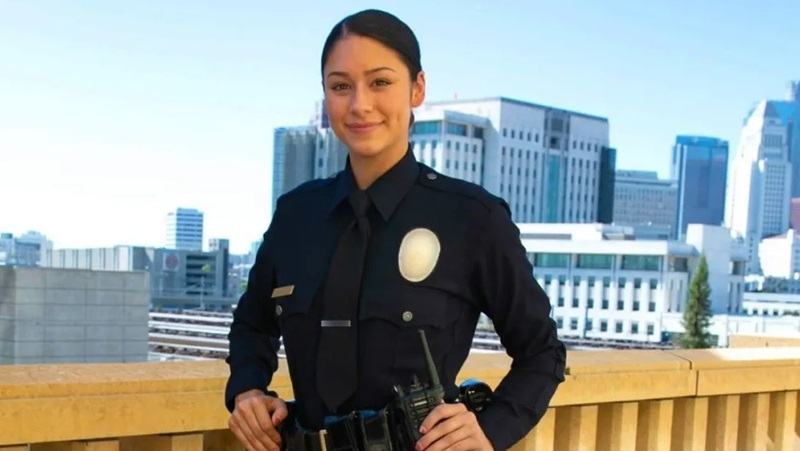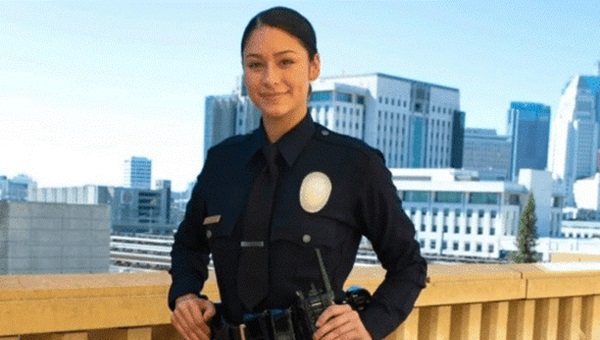
By Steve Pomper

I have a sweet follow up for you. Well, perhaps, it’s somewhat bitter-sweet because this outstanding cop shouldn’t have been put through this ordeal in the first place.
LAPD Ofc. Toni McBride was involved in an officer-involved shooting (OIS) in April 2020 (you can refresh yourself with these NPA articles, #1, #2, #3), including the NPA’s amicus brief filed on Ofc. McBride’s behalf. The incident resulted in the death of an armed suspect who’d charged at her with a knife. The LAPD Use of Force Review Board and the Chief of Police had correctly determined that all six shots she fired were within department policy.
Regardless, the LAPD Civilian Police Commission ruled that two of the shots she fired violated LAPD policy. The commission had voted 4-1 that shots five and six were “out of policy.” This means a majority of the commission were certain the still armed suspect posed zero threat to officers or bystanders—with what, their oh, so superior, knowledge of police work?
Fortunately, and finally, a hearing officer overseeing the officer’s appeal, after reviewing the evidence, has cleared her of those policy violations. Ofc. McBride’s father, Det. Jamie McBride, president of the Los Angeles Police Protective League, had prudently advised his daughter to file an administrative appeal.
Det. McBride told me by email, “After four years waiting for her admin appeal, Toni had her day recently and the hearing officer ruled in her favor. Chief Choi immediately signed off on it, overturning her out of policy shooting. Over the last four years this has weighed heavy on Toni, which actually caused her to have some medical problems.”
Stress-related health issues are common among falsely accused cops who suffer spiritual wounds and moral injuries inflicted by officials who betray them.
Still, this ruling is sweet because a stellar police officer can finally exhale after having her heroic police actions second-, third-, fourth-, and etc. guessed for years by civilian bureaucrats. It’s also sweet that the officer’s family can finally relax because their loved one, who’d long ago been cleared criminally of wrongdoing, has now been absolved of a remaining errant policy violation, which was strangling her career.
But the exoneration is also bitter because Ofc. McBride should never have had to suffer this mental anguish. Of course, following any OIS, an investigation (shooting review, whatever…) must occur. A critical review or investigation will only improve overall police performance—but only if it’s done honestly and is not tainted by anti-cop biases or ignorance.
It’s even more than bitter when another less-knowledgeable (perhaps, more political) “commission” upends the findings of astute law enforcement professionals had already reached the reasonable and correct conclusion that all shots fired were within department policy.
Here’s a quick recap of the incident. Responding to a 911 call, Ofc. McBride and her partner came upon a multiple-vehicle collision. The officers learned that a suspect driver had intentionally crashed into several occupied cars (vehicular assault), resulting in injured victims.
Witnesses then reported that the suspect, armed with a razorblade boxcutter, was in his truck attempting to “kill himself with a knife.”
On video, you can see the armed suspect emerge from behind the truck and stride menacingly toward Ofc. McBride who’d placed herself between the danger and innocent bystanders. She repeatedly orders the suspect to drop the weapon. Instead, he flares his arms and surges toward the cop.
Ofc. McBride fires at the suspect twice, and he falls to the ground. The suspect immediately gets up and continues toward the officer who, only then, fires two more rounds. The suspect again falls to the pavement.
Again, knife still in hand, the suspect immediately attempts to get up. Ofc. McBride fires two more rounds, stopping the threat. Obviously, the officer could not be sure where any of the rounds had struck and how physically capable the armed suspect remained.
If you think no one could get up after being shot two, four, or even six times, consider these brief examples.
I responded to a domestic violence attempted murder-suicide attempt. The suspect had shot is girlfriend multiple times and then himself in the head. He died; she lived. The lead homicide detective later told us the suspect had shot his girlfriend nine times. Yet, I saw her animated and talking as medics rolled her on a gurney to the ambulance.
Even more applicable, there’s the Montgomery County, Maryland OIS, as reported by TruthAboutGuns.com. Witness cellphone video shows a man threatening a deputy with a four-foot wooden walking staff (club). The suspect advances, causing the deputy to walk backward, increasing his risk of stumbling.
The deputy didn’t fire until after the suspect had struck him, breaking the club over the cop’s left arm, and as the suspect hurls the remaining portion of the club at him. Who knows what caused the deputy to hesitate (except that he obviously didn’t want to shoot the guy), but hesitation can be deadly for cops.
Even the witness who was video recording the incident kept shouting from inside his car for the cop to shoot, as the suspect kept trudging toward him. The deputy finally fired 12 rounds directly into the suspect from close range before the suspect stopped and collapsed to the pavement.
I can hear it now. A civilian review panel criticizes the officer for shooting the suspect 12 times when he was merely holding a stick (oh, and by the way, what’s that nonsense about never needing more than 10 rounds?).
One thing that stuck out for me in Ofc. McBride’s appeal report was a comment from a use-of-force expert witness, who was “selected by the California Department of Justice as a consultant in their evaluation of this shooting.”
The document noted that the expert witness found the officer’s “shots to be amazingly accurate, with all six rounds hitting the target while he was moving in a dynamic situation.” Further, the doctor opined “only one in 90,000 officers would’ve been able to be that accurate with those shots.”
Don’t underestimate the importance of accuracy, especially while under stress, regarding the risk to bystanders from rounds that miss the target. Another crucial aspect to remember is the suspect had the power to stop advancing on the officer and to drop the blade at any time to end his crime spree.
I also noticed in the final report that the highly trained and skilled Ofc. McBride, who’d done her job properly, was directed to attend “retraining.” As a former FTO, I don’t believe that she’s the one who needed retraining.
As for the officials arriving at these erroneous policy violations, disregarding what a reasonable officer would do, and not seeming to understand what amounts to a lethal threat, I’d say, they are the ones who need additional training.
Good luck to Ofc. McBride on her career and life goals.